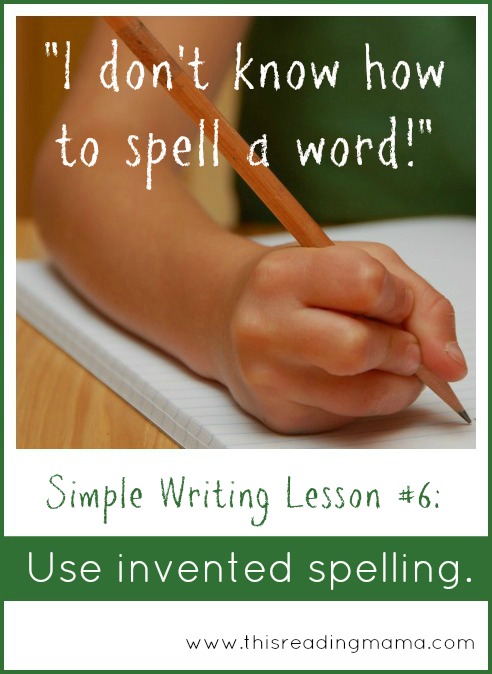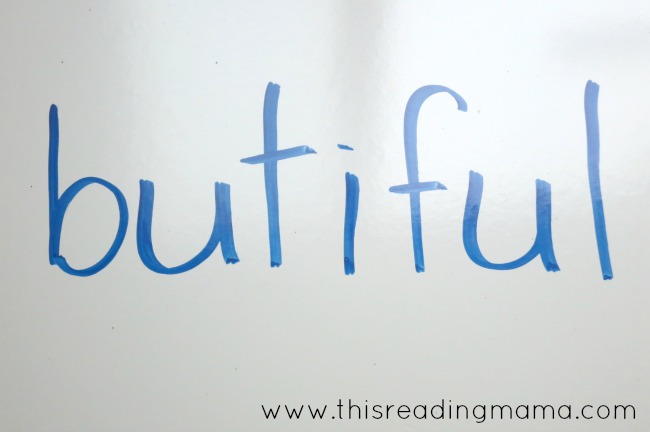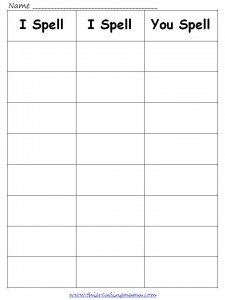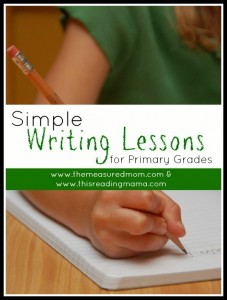
Welcome back to Simple Writing Lessons for the Primary Grades, a 12-week collaborative writing series, hosted by The Measured Mom and This Reading Mama (that’s me)! If you have missed any of the lessons we’ve covered so far, click here to see the introduction and links to the lessons (scroll down).
Simple Writing Lesson #6: Use Invented Spelling {a writing strategy}
My favorite thing about teaching writing as a craft is that kids are treated as authors who can make their own choices. They don’t have to write about my topic or prompt. I may pick a certain genre to study {like writing a letter or narrative stories}, but I give them free reign to run with their own ideas. This is a wonderful and scary feeling all at the same time because it means young writers get to explore their creative side, but I also lose “control”. It’s not neatly packaged.
Part of losing that control comes with spelling as well, especially in the rough draft stage. I want my child to have the freedom to explore language and play with words as an “author”. This means {hold your breath if you’re Type A} that my child may actually spell some words in a non-conventional way. To some, it’s known as “wrong”. And guess what? I encourage it {even though I’m Type A, too} because invented spelling is a wonderful tool we can use to see what the child understands/does not understand about how words work! I hope you’re ready to explore invented spelling when you’re child says:
“I don’t know how to spell a word!”
(Note: I am sharing examples from my son’s writing in grade 1. This same lesson can easily be adapted for students in any grade, if they are developmentally ready for it.)
How to teach it:
1) Prepare your materials.
- Your child should have a pencil and a piece of paper or a notebook to write in.
- Rubber band
- A dry erase board or paper for demonstration purposes
2) Demonstrate how to stretch out sounds in a word.
When I first introduced the concept, I said something like:
“Sometimes when we’re writing, we want to use words we’ve heard before, but we’re not sure how to spell. Big words. Important words. Words like beautiful or outrageous. It may even be smaller words like crawl or thought. These kinds of words are not words on our word wall {sight words} or patterns we’ve studied with our word sorts*. I want to show you what you can do while you’re writing to help you use and spell those words by yourself.
“Let’s use the word beautiful for example. If I want to spell that word, but I’m not sure how, I can do something cool. See this rubber band? I’m going to s-t-r-e-t-c-h it out. Just like I’m going to stretch out the word beautiful. I stretch out a word by saying the sounds in that word very slowly.” I say beautiful very slowly. I don’t add any extra sounds, just the ones I hear.
“Do it with me.” We both say beautiful very slowly while he stretches out the rubber band.

*Please note that I require my child to spell all sight words and word patterns we’ve studied together conventionally {correctly}. Using invented spelling is not a substitute for holding kids accountable for what they know.
3) Demonstrate how to write down the sounds in a word.
“Now, that I’ve stretched out that word, I can write down the sounds I hear in that word, starting at the beginning. Let’s stretch it again, this time saying in a little slower and I’ll write down all the sounds we hear.

“B–U–T–I–F–U–L” {Remember that we’re emphasizing each sound, not each necessarily each letter.} As we say the sounds, I write down all the sounds we can feel with our mouths and hear with our ears. {By the way, this is GREAT for phonemic awareness, an essential skill in reading!}
We try it with a few more words together. Words like favorite, because, and furious. We stretch out the word, listen for the sounds, then write them down.
4) Ask the child to give invented spelling a go with your support.
Give your child another word, this time asking your child to write down the sounds. It might sound like this:
“Now it’s your turn to try it out. Let’s say you were writing and you wanted to spell the word bicycle, but you weren’t sure how. Let’s use the rubber band idea and stretch out bicycle.
“B–I–S–I–K–L” Ask the child to write down all the sounds he hears. Please note that students in different learning stages of development will spell words differently. Younger students may leave out the vowels, while older students will get more of the sounds.
Here are some of my son’s {from 1st grade} invented spellings** during this independent writing time.
 **These are examples from my child’s “rough drafts”. If and when he decides to take a piece further by “publishing” it, we do correct the invented spellings. {Stay tuned in the weeks ahead as The Measured Mom and I move into editing to publish during our 12-part series.}
**These are examples from my child’s “rough drafts”. If and when he decides to take a piece further by “publishing” it, we do correct the invented spellings. {Stay tuned in the weeks ahead as The Measured Mom and I move into editing to publish during our 12-part series.}
5) Wrap up the lesson.
“Remember when you’re writing and you get to one of those bigger words, try stretching out the word like we did with all those words today. Say them slowly. Listen to the sounds you hear and write them down.”

Feel free to also try “I Spell, You Spell” to encourage invented spelling, a FREE download.
This is the sixth lesson in a 12-part series for Primary Grades. Click HERE or the image below to view more simple writing lessons.
~Becky

I love the rubber band visual! I was at a training a few years back where we were discussing invented spelling, but the trainer used the term “estimated” spelling, which I thought was interesting and gave more meaning to that process of spelling hard words.
What a great lesson! I love invented spelling. I did this with my homeschool children in the early 1990’s and guess what? When they transitioned to public school in middle school, all their teachers were amazed they were such creative writers! Two out of three are fabulous spellers and the other one uses a dictionary–can you believe it? I’m going to go through every post on this blog 🙂
This is the same approach they use in the public schools. They did this when my son was in K5 many years ago, and it took years to break the patterns they established with inventive spelling. He thought he was spelling words correctly because they would not correct his spelling, and he was confused (and thought I was wrong) when I corrected him. It has caused delays in his ability to write and damaged his confidence to write even something as simple as a paragraph because he found out he really didn’t know how to spell the words he thought he could spell.
Children can be taught correct spelling and the phonetic sounds the correct spelling makes. I know this may not be your opinion, but I believe parents should understand the problems that can occur when using the inventive spelling method. Your method of stretching the sounds out like a rubber band is good, but I would encourage you to not put before their eyes incorrect spelling to go with those sounds. You probably would not teach them that 2 + 2 = 5 because you want them to learn math facts correctly, so why not use the same approach with spelling?
I am so sorry that the teachers of your son overused and abused invented spelling. Invented spelling is not meant to be a substitute for learning to spell correctly. I agree that kids need to be held accountable to the sounds and patterns they have already learned and should not be allowed to continue misspelling words they already know. We should correct their spellings in these cases. For example, in my post, my son’s spelling of COULD {COOD} was not allowed after he learned it as a sight word.
What I do fear, however, is that we can over-correct a child’s spelling so much that he shuts down and won’t spell words or be creative with his word choices unless we are sitting right there spelling every word for him. I’ve seen this happen many times in the classroom. Kids end up writing, I SEE A CAT. for a sentence because it’s “safe”. They can spell all the words conventionally. There’s no creativity involved. No chance to explore the English language for the sake of doing it the “right way”. And a big problem with this approach is that kids have SO many more words in their vocabulary than they can spell conventionally. They are very limited if we only allow the conventional spellings. Now, on the flip side, if I allow the invented spellings and then the child wants to make that writing into a book or “publish” it, I will correct those spellings before it’s a finished product.
Children should also be taught correct spellings when they are developmentally ready for it. The math mistake of 2+2=5 is such a concrete example and most young children are developmentally ready to be shown the correct answer. Yes, I would demonstrate that one and show them their mistake. But if that same young child came up to me and incorrectly repeated an algorithm or formula that he’d overheard my husband use in his engineering job, I would not take the time to go through and explain the correct way of doing it. He would not be developmentally ready for it because it is not concrete, but very abstract.
Thank you for the perspective you bring to the table on invented spelling. Ultimately, we must do what benefits our child the most and it sounds like you’re doing that with your son.
I was interested to read the comments. I appreciate it that in my daughter’s school the teacher circles around an incorrectly spelled word, but doesn’t correct it unless it’s the word that they are supposed to know already. It gives a learner a chance to ask about correct spelling if she wants to, but doesn’t discourage her from trying. At home she is more “perfectionistic” (it looks like it’s not a word :)) and usually asks me how to spell the words she doesn’t know.
I am a kindergarten teacher and I read your post, because I saw ” I don’t know how to spell” this is a phrase I hear OFTEN in my class. Many students are afraid of spelling a word incorrectly therefore they choose not to try at all. I feel that there is less and less creativity and imagination in their writing each year.
I LOVED this post and I am going to attempt it next week. Thank you for sharing.
Yes, this is a great age to work on invented spelling. It takes a lot of modeling before kids begin to realize they have permission to try it themselves. And every child’s invented spelling will look different, depending on their developmental level of word knowledge.
going to give it a try with a 7 and a 5 year old. wish me luck!!!